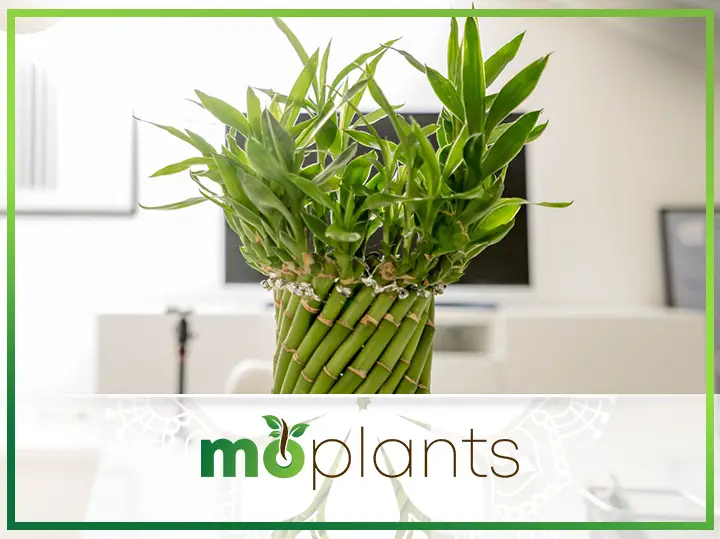Known for its beautifully sculpted and twisted stalks, lucky bamboo is more than just an ornamental houseplant meant to brighten up your home and office. This exquisite plant also serves as a natural air purifier and brings good luck and good fortune to the household. So, if you are looking for an indoor plant that is attractive, forgiving, and good for Feng Shui, there is no better option than growing lucky bamboo.
This popular houseplant is native to Central Africa and parts of Southeast Asia, where it has been growing for the past 5,000 years. The lucky bamboo plants are a popular décor trend in both home and business settings. You can use these striking plants to add a pop of color to any room in your house or place it on your workstation to jazz up the space.
One of the most notable features of lucky bamboo is its intricately shaped stalks. Professional growers laboriously twist, curl, and braid the stalks of this auspicious houseplant to give it an eye-catching appearance. The stalks of lucky bamboo can also be trained to grow straight as an arrow, giving plant lovers various options to choose from.
Some of the most common names of lucky bamboo include Chinese water bamboo, Friendship bamboo, Goddess of Mercy plant, Curly bamboo, Belgian evergreen, and Ribbon plant.
Introduction: Lucky Bamboo
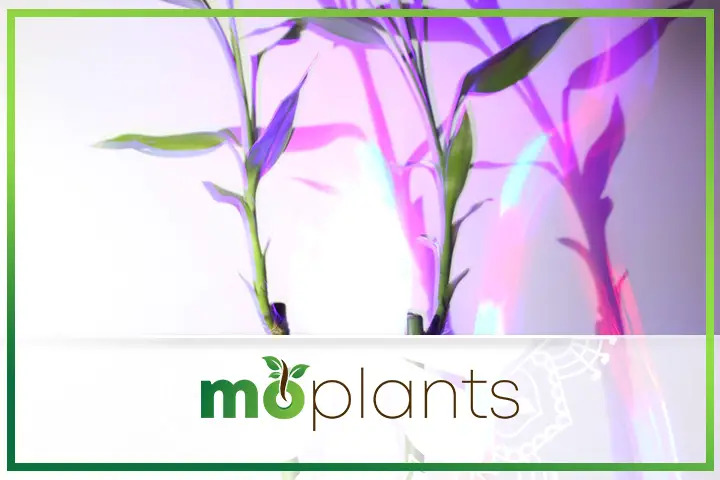
The botanical name of lucky bamboo is Dracena sanderiana. It is named after renowned German-English gardener Henry Frederick Conrad Sander. Interestingly, despite its name and appearance, it is not related to bamboo at all. While it grows almost just as fast, the lucky bamboo plant belongs to the Asparagaceae family and is a type of water lily.
This houseplant plant is perfect for beginners as it doesn’t require much attention and will continue to thrive as long as you water and feed it regularly. It is also very tolerant of less-than-ideal conditions, so you don’t have to worry about accidentally killing it with neglect. Moreover, you can grow this plant either in water or soil, depending on your preference.
The branches of lucky bamboo are mostly naked, with tufts of thin, floppy leaves at their ends. As the plant matures, its leaves develop into offshoots and can be manipulated to take on a multitude of aesthetically pleasing shapes. If you want the plant to grow taller, refrain from cutting its stalk. Instead, clip the offshoots at the base to grow more plants.
Furthermore, lucky bamboo is a perennial shrub. In its native habitat, the plant produces small white flowers during the fall and winter seasons. However, you are not likely to see a domestically cultivated plant bloom indoors. In addition, the lucky bamboo plant can grow up to three feet tall and two feet wide in an average home environment, with its leaves growing up to an inch per month. A healthy plant can reach its full height in less than two years.
It also makes for an excellent housewarming gift. According to the principles of Feng Shui, lucky bamboo attracts prosperity, generates wealth, spreads positivity, brings love, bestows good health, and improves fertility. The mesmerizing houseplant is also good at removing pollutants from the air and promotes a healthier indoor environment.
How to Grow Lucky Bamboo
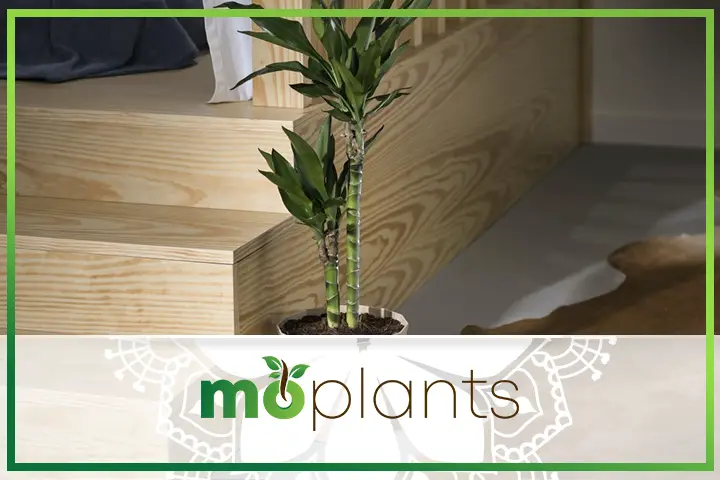
You can grow lucky bamboo in a water-filled vase or plant it in soil. You can also propagate it in water and then transfer it to a planter to ensure the plant remains happy and healthy for a long time.
Here are some tips on how to grow lucky bamboo that you may find helpful.
Placement
Lucky bamboo prefers bright but indirect light. Therefore, you should consider placing this houseplant near a window in your living room, dining room, or workplace. If you are growing the Feng Shui plant, you should ideally place it in a southeast corner of your living room.
Ideal Temperature
Being native to the tropical Central African climate, the lucky bamboo plant prefers moderately warm temperatures ranging between 65 and 95 degrees Fahrenheit. You must not place it near open windows or places with draft during winter months, as exposure to cold air can be detrimental to its growth. You should also avoid placing this plant in front of an air conditioner.
Humidity Level
Lucky bamboo flourishes in humid environments. If you live in a place with humidity levels way below 50%, you may want to invest in a humidifier to help the plant stay fresh. However, if that’s not possible, regularly misting the plant or placing it on a pebble tray filled with water can be good alternatives.
Exposure to Sunlight
You should never place your lucky plant under direct sunlight for long periods, as the harsh sun rays will burn the leaves. The lucky bamboo plant thrives in bright but filtered light, but it can survive in relatively dark corners of your home as well.
Watering Frequency
Whether you are growing lucky bamboo in a glass vase or a terracotta pot, please make sure to use distilled or filtered water. The houseplant may have an easygoing nature, but it is rather sensitive to chlorine and other chemicals found in tap water. Moreover, the plant prefers moist soil, but it shouldn’t be completely soaked. Watering lucky bamboo once a week is generally enough.
Potting Mix and Container
Lucky bamboo grows well in slightly acidic potting media. Therefore, make sure to buy rich and well-drained soil with pH 6.0 to 6.5. Meanwhile, if you plan to grow lucky bamboo in water, you can fill a vase with pebbles and ensure it always has at least an inch of standing water.
It is also worth mentioning that lucky bamboo has red roots. So don’t be startled when you can see the deep red roots floating in the water.
Infographic
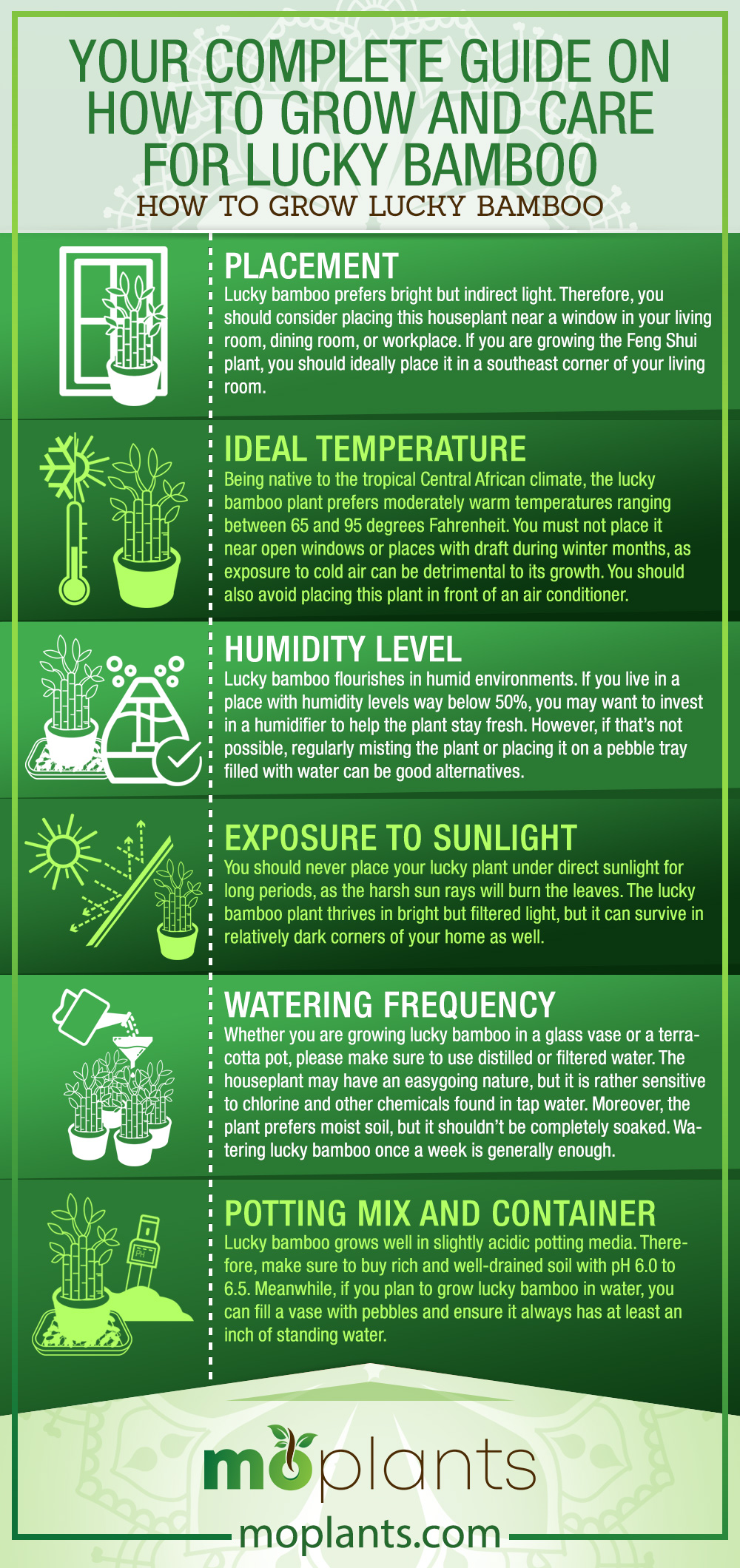
Lucky Bamboo Propagation Method
As mentioned above, you should not propagate lucky bamboo by cutting off its stalk. Instead, you can create new lucky bamboo plants by clipping one of the offshoots.
The most popular lucky bamboo propagation technique involves cutting an offset with at least one leaf joint and trimming it to expose the growth nodes. Please make sure to use a sharp and sterilized knife for this purpose. Next, you can put this cutting in a glass jar and submerge its bottom end in distilled water. It will take about a month for the trimmed offset to develop red roots, after which you can transfer the plant to a pot with soil or a container with pebbles and water.
However, until the roots develop, make sure to change the water every three to four days and keep the jar clean to prevent algae and bacterial growth. Moreover, make sure the water always covers the growing roots. You can also add a drop of well-balanced liquid fertilizer to the water to help the plant grow.
Lucky Bamboo Care Tips
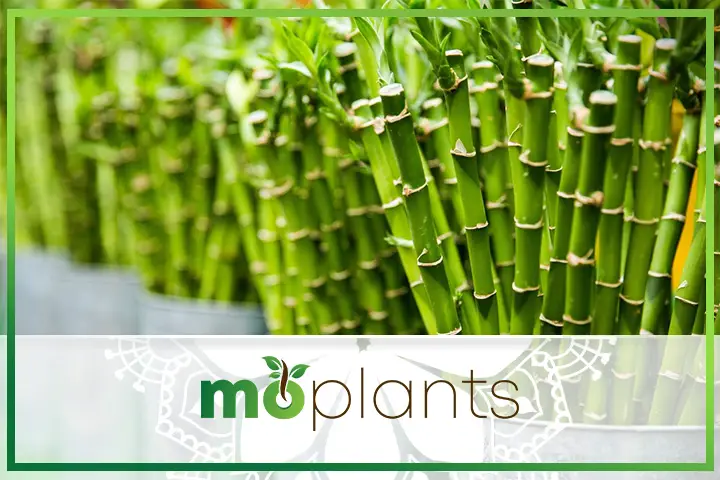
Caring for lucky bamboo plants doesn’t require much effort. However, if you want your houseplants to look fresh and well-maintained, consider taking some time out of your schedule to look after them.
Here are some lucky bamboo care tips that you must know about.
Pruning and Trimming
As the plant ages, its intricately twisted and braided stalks may begin to lose their shape. If you want your lucky bamboo to retain its shape, you should regularly trim its leaves and offshoots. The best way to keep your plant healthy and beautiful is to cut the offshoots within an inch of the stalk using a clean knife. A new shoot will grow from the trimmed spot within the next few weeks. If you don’t want a bushy plant, dip the cut end in paraffin to stop new growth.
Balanced Fertilizer
For a lucky bamboo plant grown hydroponically, a single drop of liquid fertilizer is more than enough to feed it for an entire month. Meanwhile, if you are growing it in soil, consider using the speciality fertilizers or opt for any weak liquid fertilizer to provide additional nutrition to your beloved houseplant.
Use Filtered Water
It is vital to keep the roots of the lucky bamboo plant moist at all times. However, do not keep them waterlogged if you are growing the plant in the soil. If you have placed your lucky bamboo in a glass vase, remember to top it off with fresh and filtered water every few days. Also, avoid using tap water at all costs as it may contain harmful chemicals.
Clean the Container
Most people prefer growing this stylish houseplant in water. If you plan to do the same, please make sure to replace the water every two to three weeks once the plant has developed its roots. Moreover, clean the container every month or two to prevent algae and mold.
Repotting
If grown in soil, you will have to repot lucky bamboo at least once a year. The best way to determine if the plant needs repotting is to look for any roots crowding on the surface or extending from the drainage hole in the pot. Once the roots become visible, dig out the plant along with its roots and move it to a larger container with fresh potting mix.
On the other hand, if you are growing lucky bamboo in a glass vase with pebbles and water, you will be able to notice when the container becomes too tight for the roots. When that happens, carefully remove all the pebbles and gently pull out the plant to avoid any damaged roots. You can either trim the roots and place the plant back into its original container or move it to a large vase.
How is Lucky Bamboo Shaped?
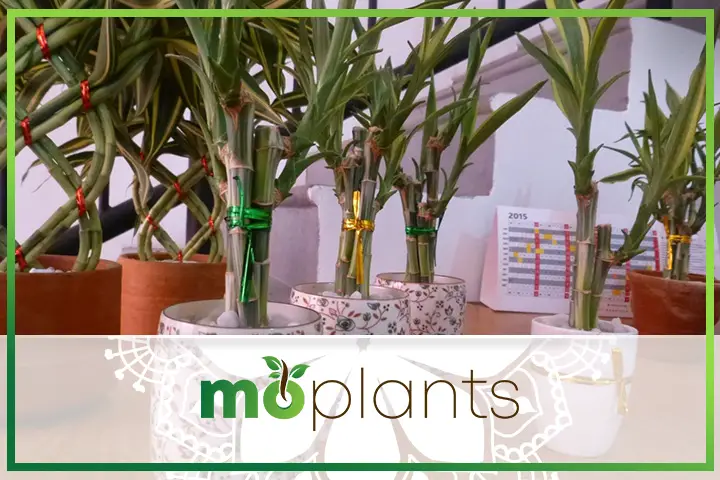
The complex shapes of lucky bamboo are created by rotating the stalks in front of a light source. Though it may sound relatively simple, it is a painstaking process that requires a lot of time and patience.
Since the stalks of lucky bamboo tend to grow towards the light, professional growers often place these plants on their sides to achieve the desired shape. They also use specially-designed boxes to grow lucky bamboo and monitor their growth rate to ensure the design looks immaculate and beautiful.
You will probably be able to find braided, twisted, and curled lucky bamboo plants in your local nursery.
Common Lucky Bamboo Problems and How to Solve Them
Now that we know the lucky bamboo care tips, it’s time to discuss the most common problems this houseplant may face and how you can fix them.
Yellow Leaves
Lucky bamboo grows in partial shade under filtered sunlight. If you place it in the sun, its leaves will start to turn yellow and eventually burn due to heat. The best way to prevent yellow leaves is to put your houseplant in a covered yet sunny location.
In addition, adding too much fertilizer can also result in yellowing leaves. So you may want to stop feeding the plant for a few weeks and keep an eye on its condition.
Brown Leaves
The leaves of lucky bamboo plants usually turn brown for two main reasons: polluted water and dry air. The high level of chlorine and other chemicals in the water can burn the stalk and slowly cause the leaves to turn brown, starting at their tips. To ensure your plant remains healthy, remove the damaged leaves and increase the humidity level in the room.
Black Roots
Lucky bamboo roots are usually red or orange, so if your plant’s roots are turning black, it may be a cause of worry. The best way to solve this problem would be to trim away the affected roots and move the plant to a clean container. Don’t forget to fill the container with fresh distilled water.
Soft Stalks
Root rot is the leading cause of stalks turning soft. Polluted water, algae, fungus, and bacteria are the main culprits behind the decay. The best course of action would be to separate the mushy stalks from the healthy ones. If they are beyond saving, you may have to throw them away and focus all your energy on treating the surviving stalks.
Common Pests and Diseases
Mealybugs, mites, and fungal infections are common pests and diseases that affect lucky bamboo plants indoors. You can wash the plant with water or use insecticidal soap to get rid of the tiny insects and infections. Neem oil is also rather beneficial to treat such conditions.
Infographic

Is Lucky Bamboo Toxic?
Lucky bamboo may bring luck to its owners, but it can be pretty unlucky for the furry companions. The stalks and leaves of this popular houseplant are toxic for cats and dogs. However, it doesn’t pose any danger to humans.
Here are some of the most common signs of lucky bamboo poisoning among pets:
- Drooling
- Incoordination
- Dilated pupils
- Vomiting
- Abdominal pain
- Diarrhea
Lucky Bamboo FAQs
Here are some of the most commonly asked questions about lucky bamboo.
Does lucky bamboo grow better in soil or water?
Typically, lucky bamboo only lasts for about a year in water before its stalk starts getting mushy and its health declines. Therefore, it is better to grow lucky bamboo in soil or move it to a potting medium after growing its cutting in the water for a few weeks.
How long does lucky bamboo live?
When grown in water, the lucky bamboo plant can live for up to two years. However, it will last for several years when transplanted in soil.
How tall does lucky bamboo grow?
On average, lucky bamboo grows up to three feet indoors, though some houseplants can also grow as tall as five feet.
To conclude, lucky bamboo is one of the most gorgeous and easy-to-grow plants you can add to your home. It can freshen up the indoor air and elevate your décor with its sophisticated design and shape.

